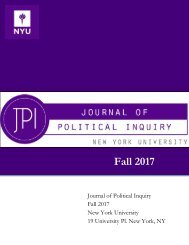JPI Spring 2018
You also want an ePaper? Increase the reach of your titles
YUMPU automatically turns print PDFs into web optimized ePapers that Google loves.
Right, a party additionally needs to display authoritarian tendencies – that is, an aggressive stance<br />
towards political enemies and a preference for a strictly ordered society” 19 .<br />
Election promises from Kaczynski and PiS included introducing a child subsidy and retirement<br />
age cut in order to appeal to the median voter while remaining true to their relentlessly conservative<br />
roots. Because of the unilateral control of media, government opposition groups have also lost<br />
influence and popularity. Judiciary reforms by the PiS, which President Andrzej Duda has attempted<br />
to fight, are much to blame for this as the PiS eliminate separation of powers.<br />
Elite-focused theories on regime transitions predict that democracies will remain stable if they<br />
maintain their “self-enforcing equilibrium” 20 . This posits that political actors will continue to support<br />
the status quo so long as it served their agenda. So, the PiS aims to alter the current status quo to one<br />
that fits their desires where they will gain equilibrium and citizens comply as they know the<br />
government will not liberalize for their benefit 21 . Although Polish political parties are not typically well<br />
institutionalized but instead are leader-centric, other parties have not deviated from the norm until PiS<br />
in the past few years who have created a small autocracy with loyal party members who force<br />
constituents to shift their way of life to make room for a once minority party to rule 22 with an iron<br />
fist. This autocracy found its members remaining loyal by promising state-sector jobs assuming they<br />
are loyal to Kaczynski which was possibly by planning for a widespread purge of civil servants and<br />
state-owned companies from the preceding administration.<br />
PiS is hostile to liberal and democratic parties, and despite their success, the Polish National<br />
Election Study does not show significant decrease in popular support for democracy and democratic<br />
institutions or a rise in favor for nondemocratic institutions 23 . This demonstrates how exclusionary<br />
populists are able to find support despite public resistance. Because the PiS satisfies demands of fringe<br />
groups (extreme and far-right conservatives) who are hardly recognized otherwise in the media or<br />
government, the voters from the end of the political spectrum will also find themselves loyal to their<br />
newfound representative who actively appeals to their extreme and conservative views. The success<br />
of PiS is further contradictory to the norm because the 2015 edition of the Polish National Election<br />
Study shows that when explicitly asked to state their preference for progress vs. tradition, individual<br />
entrepreneurship vs. social solidarity, and freedom vs. equality, in each case respondents preferred the<br />
first to the second option, by about 55 percent vs. 34 percent.<br />
The primary difference between Poland and the United States’ approach to populism is that<br />
the PiS has become more radical and critical of liberal-democratic governments and across the party<br />
and its leaders are unified within this perspective. The PiS has 235 members in the Sejm out of a<br />
possible 460, meaning they are a majority and have autonomous power. Autonomy is useful in this<br />
case for PiS because decisive actions are free from political manipulation from outside the party,<br />
however, this means unchallenged authority of the PiS.<br />
19<br />
Kai Arzheimer (2015) The AfD: Finally a Successful Right-Wing Populist Eurosceptic Party for Germany?, West European Politics, 38:3, 535-<br />
556, DOI: 10.1080/01402382.2015.1004230<br />
20<br />
Prezworski, Adam. “Democracy as an Equilibrium” <strong>Spring</strong>er Link, Kluwer Academic Publishers, 05 February 2014.<br />
https://link.springer.com/article/10.1007%2Fs11127-005-7163-4.<br />
21<br />
Kelly, Lidia and Pawlak, Justyna. Poland's Far-Right: Opportunity and Threat for Ruling PiS. Reuters, 3 Jauary. <strong>2018</strong>.<br />
22<br />
Cienski, Jan. “5 Takeaways from Poland's Election.” POLITICO, 27 Oct. 2015, www.politico.eu/article/5-takeways-polish-election-2015-law-justicecivic-voters-kaczynski-tusk-eu-pis-szydlo/.<br />
23<br />
Jerzyński, Tomasz W. “Polish National Election Study (PGSW)”. ADS – Description of Data Set, 2015.<br />
<strong>JPI</strong> Fall 2017, pg. 22
















